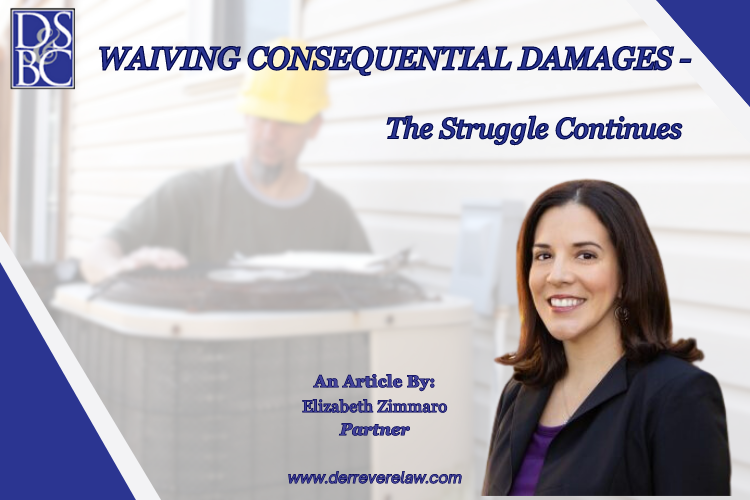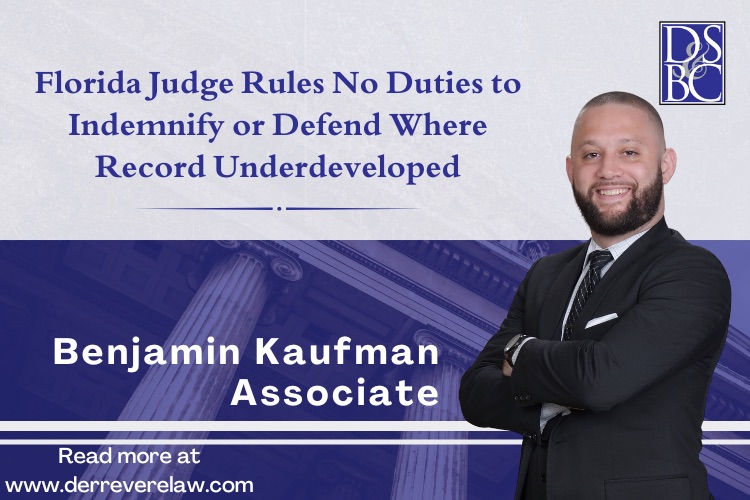Waiving Consequential Damages – The Struggle Continues

Consequential damages waiver clauses are found in almost all standard construction industry contracts. Not surprisingly, parties want to avoid the economic impacts of unforeseen consequences. Yet all too often, we find ourselves litigating over the enforceability of consequential damages waivers because the confusion about these clauses is so widespread. Why are these boilerplate standard waivers so problematic? The two main reasons are: 1) nobody can agree on what consequential damages are; and 2) the consequential damages waivers are often ambiguous.
So, what exactly are consequential damages? The term seems pretty straight forward, but if you’ve been an attorney long enough, you know that very little is black and white. We are experts at navigating gray areas, and, as if to recognize the need for guidance, Florida courts provided us with a roadmap to assist us in analyzing damages by dividing them into 3 categories: general, special, and consequential.
General Damages
General damages are those which naturally flow or result from the injuries alleged. They are commonly defined as those damages that are the direct, natural, logical, and necessary consequences of the injury. For example, let’s say Bob hires Joe to repair his AC unit and pays Joe $3,000 in exchange for Joe’s performance of the repair. If Joe breaches the contract by failing to repair the AC unit, Joe owes $3,000 to Bob in general damages.
Special Damages
Special damages are monies that will compensate a plaintiff for damages that do not normally result from a breach. To recover special damages, the plaintiff must prove that when the parties made the contract, the defendant knew or reasonably should have known of the special circumstances leading up to such damages. They consist of items of loss that are peculiar to the party against whom the breach was committed and would not be expected to occur regularly to others in similar circumstances. Let’s take things a little further in our example above with Bob and Joe. Bob told Joe that he needed his AC unit to be repaired because his grandmother who lives out of state planned to visit him next week and could not stay at his home if the AC was not working. Joe told Bob the repair would be simple and could be completed in a few hours on Monday morning. Monday morning just so happened to be the day that Bob’s grandmother was to arrive. Joe breached the contract by failing to perform the repair, and Bob had to pay for his grandmother to stay in a hotel during her visit. The cost of Bob’s grandmother’s hotel stay would be considered special damages because the loss is peculiar to Bob and his circumstances.
Consequential Damages
The distinction between consequential damages and general damages lies in the loss incurred by the non-breaching party in its dealings with third parties. “Consequential damages do not arise within the scope of the parties’ transaction, but rather stem from foreseeable losses incurred by the non-breaching party in its dealings, often with third-parties, such as costs of repair.” In Keystone Airpark Authority v. Pipeline Contractors, Inc, 266 So.3d 1219 (Fla. 1st DCA 2019), the First District relied on several cases throughout the country that illustrated the differences between consequential damages and general damages. In Urling v. Helms Exterminators, Inc., 468 So.2d 451 (Fla. 1st DCA 1985), the First District found that the cost to repair extensive termite damage to a home purchased after a termite inspection company erroneously certified that the home was free of damage constituted consequential damages, whereas the cost of the termite inspection constituted actual damages. The Eastern District of Virginia found that a property owner’s cost to correct structural defects that resulted from defective plans prepared by an architect constituted consequential damages. The Eastern District of Virginia also found that the cost to repair a leaking roof caused by an architect’s defective plans constituted consequential damages. While the differences among the three categories of damages may not be clear cut, Keystone provides a general framework that serves as a helpful guide.
How can a consequential damages waiver clause be ambiguous? Florida Courts allow parties to limit their remedies, including their liability for consequential damages so long as the terms of the contract are clear and unambiguous. Courts have found consequential damages waiver clauses to be ambiguous and unenforceable when the clause’s language was unclear as to the circumstances to which it applied.
Take the following example:
“Owner releases, and agrees that Contractor will not be held liable for any damages to the premises, nor for loss or damage, consequential, incidental or direct, including but not limited to any: theft, vandalism, wind; storm, rain, fire, flood; lightning strikes, force majeures; owner’s moving, eating or rental expense or income; disruption of services including utilities. In the event that any work performed by Contractor is wholly or partially destroyed or damaged due to theft, vandalism; wind; storm; rain; fire; flood; lightning strikes; force majeure or any other causes not under Contractor’s control, the loss shall be sustained by Owner and shall not be the responsibility of the Contractor.”
The contractor will argue that this waiver clause deals with two aspects of damages; 1) damage to the premises; and 2) damages to the contractor’s work. The first sentence arguably means that the contractor is not liable for any damages to the premises, regardless of whether those damages are considered direct or consequential and regardless of the source. The second sentence deals with damage to the contractor’s work and provides that the Owner will be responsible for the loss if the work is damaged by circumstances outside the contractor’s control. The owner, however, will argue that the waiver is ambiguous and contradicts itself.
Owner on the other hand, will argue that there is a direct conflict between the first and second sentence because the first sentence absolves the contractor from liability for damages to the property, while the second only absolves the contractor from liability in the event the damages to the premises are outside of contractor’s control, and that the “premises” arguably includes the contractors’ work.
Another example is:
“The Consultant and Owner waive consequential damages for claims, disputes, or other matters in questing arising out of or relating got this Agreement. This mutual waiver is applicable, without limitation, to all consequential damages due to either party’s termination of This Agreement.”
While this clause from the outset may appear to bar the Owner’s consequential damages claims against the consultant in a potential breach of contract claim, the second sentence calls into question the applicability of the waiver. The second sentence could be interpreted to mean that the only consequential damages that are waived are those that arise following termination. The clause’s ambiguity runs the risk of rendering it unenforceable.
You can avoid the consequential damages waiver pitfalls by: 1) educating yourself on what consequential damages are; 2) drafting well written clauses that are not potentially self-contradictory nor open to multiple interpretations; and 3) listing out the damages that are being waived, i.e. lost profits, increased labor and material costs, rental expenses, loss of use, etc. Acquiring a deeper knowledge and understanding of what consequential damages are will allow you to better draft an enforceable consequential damages waiver clause for your client’s benefit.
[1] Hardwick Properties, Inc. v. Newbern, 711 So.2d 35, 39 (Fla. 1st DCA 1998) quoting Hutchinson v. Tompkins, 259 So.2d 129 (Fla. 1972)
[1] Keystone Airpark Authority v. Pipeline Contractors, Inc. 266 So.3d 1219 (Fla. 1st DCA 2019) citing to Fla. Power Corp v. Zenith Indus. Co 377 So.2d 203, 205 (Fla. 2d DCA 1979)
[1] Hardwick Properties, Inc. v. Newbern, 711 So.2d 35, 39 (Fla. 1st DCA 1998) citing to Jonson v. Monsanto Co, 303 N.W. 2d 86 (N.D. 1981)
[1] Keystone Airpark Authority v. Pipeline Contractors, Inc. 266 So.3d 1219 (Fla. 1st DCA 2019)
[1] Keystone Airpark Authority v. Pipeline Contractors, Inc. 266 So.3d 1219 (Fla. 1st DCA 2019) citing to Urling v. Helms Exterminators, Inc. 468 So.2d 451 (Fla. 1st DCA 1985) and to Bartram, LLC v. Landmark Am Insurance Co., 864 F. Supp. 2d. 1229, 1240 (N.D. Fla. 2012)
[1] Keystone Airpark Authority v. Pipeline Contractors, Inc. 266 So.3d 1219 (Fla. 1st DCA 2019) citing to Fed. Reserve Bank of Richmond v. Wright 392 F. Supp. 1126, 1131 (E.D. Va 1975)
[1] Keystone Airpark Authority v. Pipeline Contractors, Inc. 266 So.3d 1219 (Fla. 1st DCA 2019) citing to McCloskey & Co., Inc. v. Wright, 363 F. Supp. 223 (E.D. Va. 1973)
[1] Amoco Oil, Co. v. Gomez, 125 F. Supp. 2d 492 (S.D. Fla. 2000)
[1] Orkin v. Montango, 359 So.2d 512 (Fla. 4th DCA 1978).



